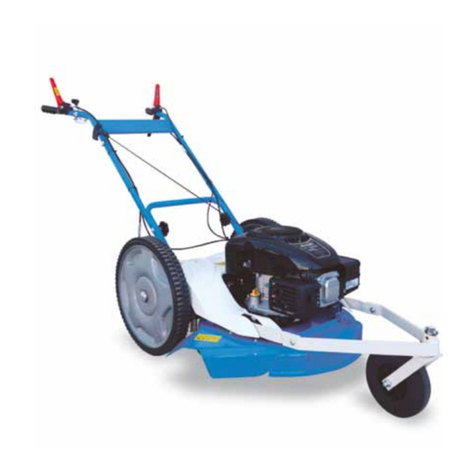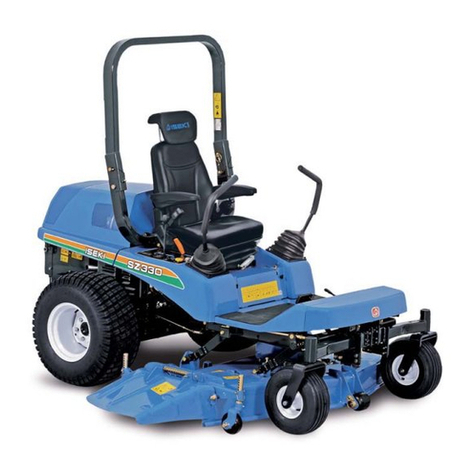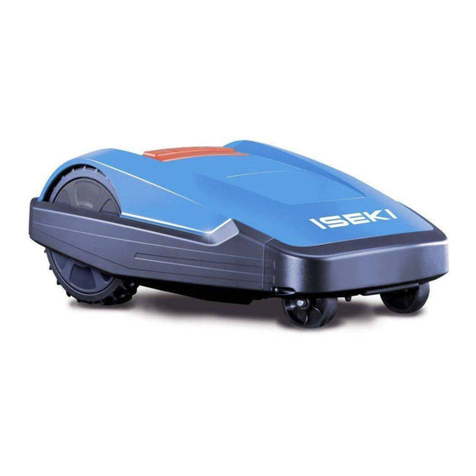
ISEKI LAWN MOWERS
3
VII. OPERATION ......................................................................................................................................................... 30
1. BEFORE STARTING THE ENGINE ................................................................................................................. 30
2. STARTING THE ENGINE................................................................................................................................. 30
3. STOPPING THE ENGINE ................................................................................................................................ 31
4. TRAVELLING.................................................................................................................................................... 32
5. STOPPING ....................................................................................................................................................... 33
VIII. MAINTENANCE................................................................................................................................................... 34
1. ENGINE OIL LEVEL ......................................................................................................................................... 34
2. TRANSMISSION OIL LEVEL............................................................................................................................ 35
3. COOLANT LEVEL ............................................................................................................................................ 35
4. FUEL LEVEL..................................................................................................................................................... 36
5. AIR-CLEANER.................................................................................................................................................. 36
6. FUEL STRAINER ............................................................................................................................................. 37
7. INSPECTION OF FUEL HOSES ...................................................................................................................... 37
8. FAN BELT ......................................................................................................................................................... 37
9. MAINTENANCE OF FRONT PTO.................................................................................................................... 38
10. ADJUSTMENT OF BRAKE .............................................................................................................................. 39
11. NEUTRAL POSITION OF HST......................................................................................................................... 39
12. INSPECTION OF WHEEL TIGHTENING BOLTS AND NUTS ......................................................................... 40
13. BATTERY.......................................................................................................................................................... 40
14. TYRE PRESSURE (INFLATION) ..................................................................................................................... 41
15. INSPECTION OF STEERING WHEEL............................................................................................................. 41
16. ENGINE OIL REPLACEMENT ......................................................................................................................... 42
17. ENGINE OIL FILTER REPLACEMENT ............................................................................................................ 42
18. TRANSMISSION OIL REPLACEMENT............................................................................................................ 43
19. REPLACEMENT OF HYDRAULIC OIL FILTER ............................................................................................... 43
20. CHAIN CASE OIL REPLACEMENT ................................................................................................................. 44
21. WASHING AND REPLACEMENT OF SUCTION FILTER ................................................................................ 44
22. INSPECTION AND CLEANING OF AIR-INTAKE OPENINGS ......................................................................... 44
23. CLEANING OF THE RADIATOR...................................................................................................................... 45
24. COOLANT REPLACEMENT ............................................................................................................................ 45
25. INSPECTION OF FUSES AND WIRING (UE TYPE) ....................................................................................... 46
26. INSPECTION OF FUSES AND WIRING (UGE TYPE) .................................................................................... 46
27. MAINTENANCE OF HYDRAULIC SYSTEM PARTS ....................................................................................... 47
28. INSPECTION OF SAFETY SWITCHES........................................................................................................... 47
29. FILLING DIAGRAM .......................................................................................................................................... 48
30. PERIODICAL INSPECTION TABLE ................................................................................................................. 49
IX. STORAGE ............................................................................................................................................................. 50
X. TROUBLESHOOTING............................................................................................................................................ 52
XI. ELECTRIC WIRING............................................................................................................................................... 57
MOWER DECKS
I. NAMES OF MAJOR COMPONENTS...................................................................................................................... 61
II. ATTACHING AND DETACHING MOWER DECK................................................................................................... 62
1. ATTACHING THE MOWER DECK ................................................................................................................... 62
2. DETACHING THE MOWER DECK .................................................................................................................. 63
III. MOWER OPERATION ........................................................................................................................................... 64
1. BEFORE OPERATION ..................................................................................................................................... 64
2. CUTTING HEIGHT ADJUSTMENT .................................................................................................................. 64
3. STARTING MOWING OPERATION ................................................................................................................. 65
4. CLEANING A MOWER DECK AND CHUTE CLOGGED WITH GRASS.......................................................... 65
5. EMERGENCY STOP........................................................................................................................................ 66
6. STOPPING MOWING OPERATION................................................................................................................. 67














































